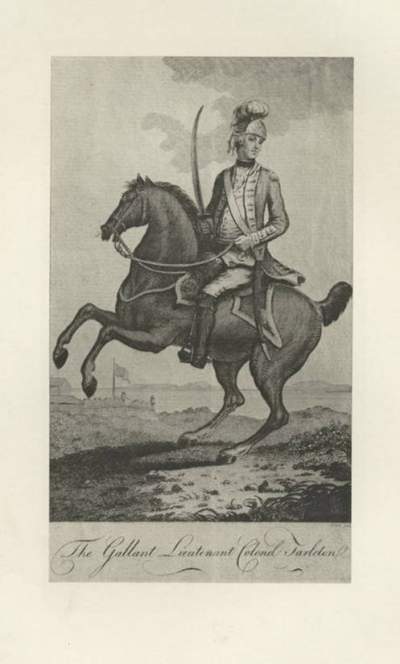


|

|
Lieutenant Colonel Banastre Tarleton, circa 1780-81
Artist: Unknown
New York Public Library

|
Throughout 1780, readers of British newspapers were electrified by reports of the brilliant exploits of a dashing young light dragoon serving George III in the American South. This new national hero was Lieutenant Colonel Banastre Tarleton, an Englishman commanding a Loyalist unit known as the British Legion. Tarleton distinguished himself by scattering the Continental light dragoons and militia cavalry that opposed him during the Siege of Charleston, South Carolina, at Moncks Corner on April 12, 1780. He then destroyed Colonel Abraham Buford's Virginia Continentals at Waxhaws on May 29, 1780. Later that year, Tarleton and his green dragoons played a pivotal role in the smashing victory that Lieutenant General Charles, Earl Cornwallis, scored at Camden over Major General Horatio Gates on August 16, 1781. The following day, Tarleton surprised 350 Rebels under the Patriot partisan leader, Thomas Gamecock Sumter, at Fishing Creek. Tarleton ended up capturing 300 Rebels and forty-four supply wagons. He also liberated 100 captured British soldiers.
These thrilling feats created a demand for young Tarleton's image. The only problem was that there was no portrait in Britain that showed him in his uniform as the commander of the British Legion. Undeterred by such niceties, one enterprising British printer released an engraving of "The Gallant Lieutenant Colonel Tarleton." He dressed Tarleton in something that resembles the standard British light dragoon uniform of the era, complete with a full-length regimental coat with lace and button chevrons on the tails. Tarleton displays an epaulette on each shoulder. His coat has slashed cuffs, with patches in its facing color extending vertically up the lower arm. The coat has winged lapels, and the lapel buttons are set in pairs. Tarleton wears a light dragoon helmet with a metal front peak and a crest made of either fur or plumes. A turban is wrapped around the base of the helmets crown, its tasseled ends hanging down behind Tarleton's head.
Note the unusual cut of Tarleton's horse blanket. His pistol covers are made of both fur and cloth. In the background is a fortified town with a brick and masonry bastion and curtain more common to European towns, and not North America. This is undoubtedly a reference to defenses of Charleston, although the actual article was hardly as formidable as what is seen here. As this engraving is the product of fancy, its value to students of British military dress during the War of Independence is negligible. It is important, however, as it testifies to the interest that the British public took in the American War. It also appears to be the first mass-produced image of Banastre Tarleton to hit the market, and testifies to the media's power to create living legends.
This article and image are reprinted from Dr. Urwin's on-going "Redcoat Images" series, with many thanks. Thanks also to Don Hagist, for making sure that I was aware of it. -- Marg B.
| Return to the Main Page | Last updated by the Webmaster on January 14, 2006 |